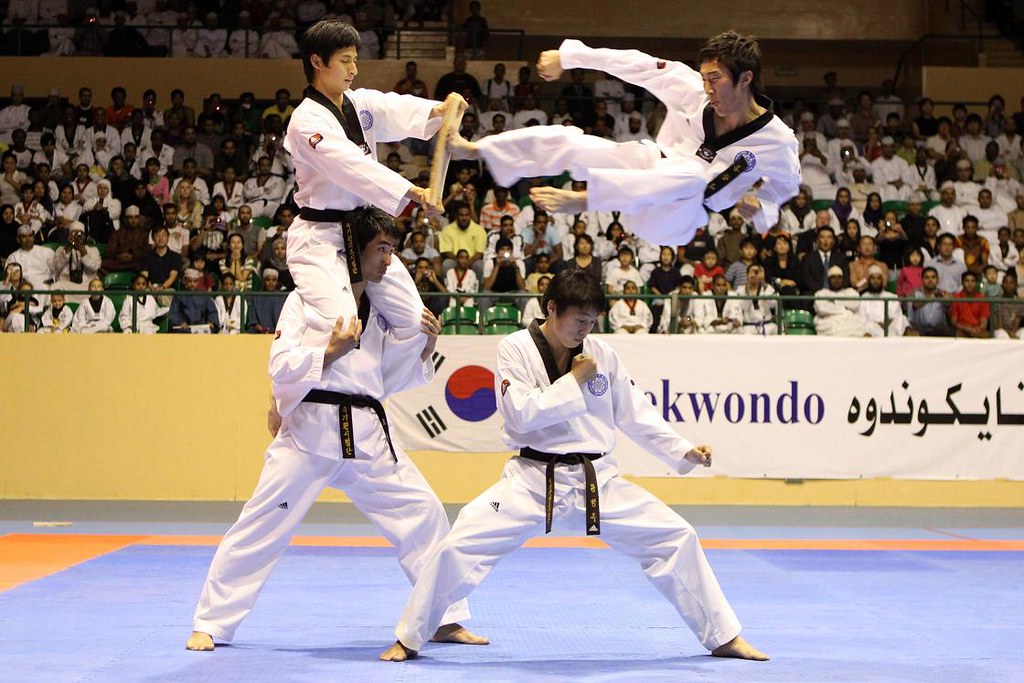Ask any martial artists what Taekwondo is known for and you’ll get a one-word answer. Kicking. Nearly all martial arts styles make use of kicks to some degree, but Taekwondo has showcased its kicking ability. But is kicking what Taekwondo is all about? Not necessarily.
It’s important to note that Taekwondo has numerous different associations that have different focuses, but it can be divided into three major categories. Self-defense oriented, sport oriented, and “flashy” oriented, so to speak. I’ll do a brief breakdown of these three throughout this blog to help differentiate them.
Taekwondo was officially created in 1955 by General Choi as both a self-defense system for the military to train and for civilians. It was also laced with historical references from Korean history. This version of Taekwondo was often referred to as, “Korean Karate”. Taekwondo was created by taking portions of numerous Korean martial arts styles into one system.
However, Taekwondo was also heavily influenced by somewhat of a taboo source, Japanese martial arts. Specifically, Shotokan Karate. There was a lot of tension between Korea and Japan in the past. Due to this, it was not overly announced that Taekwondo was influenced by Japanese arts. Understand though that General Choi, the father of Taekwondo, was an accomplished black belt in Shotokan Karate.
This Karate experience obviously had heavy influence in the development of Taekwondo. Karate is well known for its hand techniques and not as well known for it’s kicking. Due to this, Taekwondo actually has a very strong base in hand techniques. Numerous strikes and blocks. In fact, there are no kicks in the two forms (poomse, tul, kata), and only a few basic kicks in the entire color belt rank system.
Even in the early black belt ranks, kicking is few and far between. So where does this “taekwondo is all about kicking” come from? The answer in that lies in a few areas. Taekyon’s influence on Taekwondo, promoting of Taekwondo, and the sport side of Taekwondo. Let’s start with Taekyon.
Taekyon is a traditional Korean art that specializes in the use of one’s legs and is a game/sport that involves the use of legs to trip or throw an opponent to the ground. This is where Taekwondo gets much of its kicking techniques. If it were not for this influence, Taekwondo would not be what it is today. It may have just fallen under the umbrella of Karate styles.
Sine wave and kicking are largely what separates Taekwondo from most Karate styles. Sine wave being how Taekwondo produces power in its strikes and kicks. This power generation isn’t overly visual though. High, crazy kicking skills are very visual in contrast. There-in lies the next part of how Taekwondo got known as the kicking art. Its brilliance in promoting.
Taekwondo didn’t get to be the most practice martial art in the world by displaying the same punches and blocks as all the well-known Karate styles. It used its kicking skills to develop unbelievable demonstrations that General Choi and his demo team performed all over the world to promote Taekwondo. Watch nearly any video on Taekwondo and you will see amazing feats of kicking and jumping. It’s mesmerizing! It generates excitement during demos and sent many viewers to sign up for classes.
General Choi and other Taekwondo practitioners knew this was the selling point of the art. So why not predominantly display it during demos? In the same vein as promoting the art, a new version of Taekwondo came about with goal of getting Taekwondo into the Olympics. As mentioned earlier in this blog, you can divide Taekwondo up into three different versions. Up until now, I’ve been referencing the first, self-defense-based version, known as the International Taekwondo Federation. In 1973, the world Taekwondo Federation, now known as just World Taekwondo, was established.
Without getting too in-depth on the matter, South Korea wasn’t too happy with General Choi teach and promote his Taekwondo in North Korea and essentially ousted him and his version of Taekwondo and replaced it with the World Taekwondo Federation. The forms (poomse, tul, kata) were changed, the sparring was altered to be more sport oriented, and sine wave was all but eliminated.
The goal was to get Taekwondo into the Olympics to help further promote the art. They were successful in doing so. To help separate Taekwondo from Karate sports fighting, the focal point was to be the kicking. Olympic style Taekwondo sparring is all but void of hand techniques in order to showcase the kicking. This is yet another cog in the machine that created the idea that Taekwondo is all about kicking.
The final piece of the puzzle lays withing the third division of Taekwondo, the “fancy” version. I hesitate to call it the “fancy” version as I simply struggle to find another way to describe it quickly. It’s not meant to be disrespectful, just the easiest way to describe it. In 1969, the American Taekwondo Association was established.
This version of Taekwondo was altered to be more widely practiced, especially by Americans. It was assumed that Americans had a different take on learning martial arts. Generally speaking, only the hardcore people trained in martial arts in America at the time. The average American wasn’t interested. The heavy and hard training methods and long-drawn-out reward system didn’t appeal to the masses.
It was believed that Americans wanted something that obtained the fancy kicks sooner and lighter contact sparring, with emphasis on “point sparring” rather than full contact. Point sparring, while it can be brutally heavy hitting, can also be more easily controlled in the contact level. This allows it to have less injuries, which makes it more acceptable by the masses.
The ATA introduced heavier kicking into their forms, and much earlier in the ranks, than its ITF and WTF counterparts. This satisfied the practitioner immediately upon training, verses having to wait numerous months or even years that the other versions required before learning the more skilled kicking techniques and sparring.
These adjustments to the art opened the Taekwondo market to children as well as the average person who normally would be too fearful of training or bored training for months before learning the more “exciting” material. The idea was brilliant and worked perfectly, albeit heavily criticized by other martial arts styles. Due to this, the ATA is one of the largest associations in the world. This explosion of Taekwondo in America, due to a version that introduced fancy kicks much earlier in training, is the final piece of the puzzle that has led many to believing that Taekwondo is all about kicking.
Kicking is obviously a big part of Taekwondo and one of the biggest attributes that separates it from all other Martial Arts. However, it’s not all about kicking. It’s hand techniques, stances, and even grappling elements are trained just as much, if not more, than it’s kicking. It’s unfortunate that those other elements get overlooked by most everyone. But, there’s no denying that Taekwondo’s kicking is the biggest reason why it’s so popular across the world.







Leave A Comment